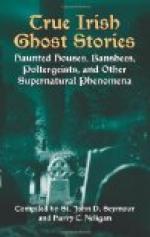CONCLUSION
The foregoing tales have been inserted, not in order that they may throw ridicule on the rest of the book, but that they may act as a wholesome corrective. If all ghost stories could be subjected to such rigid examination it is probable that the mystery in many of them would be capable of equally simple solution—yet a remnant would be left.
And here, though it may seem somewhat belated, we must offer an apology for the use of the terms “ghost” and “ghost story.” The book includes such different items as hauntings, death-warnings, visions, and hallucinations, some of which obviously can no more be attributed to discarnate spirits than can the present writer’s power of guiding his pen along the lines of a page; whether others of these must be laid to the credit of such unseen influences is just the question. But in truth there was no other expression than “ghost stories” which we could have used, or which could have conveyed to our readers, within reasonable verbal limits, as they glanced at its cover, or at an advertisement of it, a general idea of the contents of this book. The day will certainly come when, before the steady advance of scientific investigation, and the consequent influencing of public opinion, the word “ghost” will be relegated to limbo, and its place taken by a number of expressions corresponding to the results obtained from the analysis of phenomena hitherto grouped under this collective title. That day is approaching. And so, though we have used the term throughout the pages of this book, it must not therefore be assumed that we necessarily believe in “ghosts,” or that we are bound to the theory that all, or any, of the unusual happenings therein recorded are due to the action of visitants from the Otherworld.




